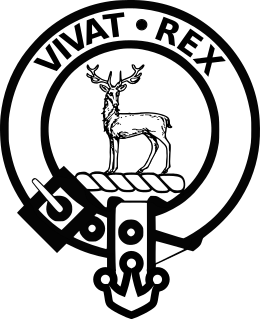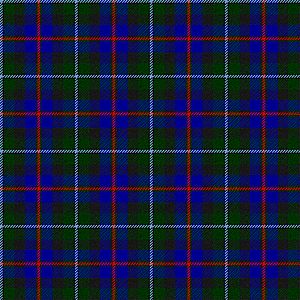Clan McCorquodale facts for kids
Quick facts for kids Clan McCorquodale |
|
|---|---|

Crest: A stag at gaze Proper attired Gules
|
|
| Motto | Vivat Rex (From Lat. Long live the king) |
| Profile | |
| Region | Highlands |
| District | Argyll |
 |
|
| Clan McCorquodale has no chief, and is an armigerous clan | |
| Historic seat | Eilean-a-Bharain Castle on Loch Tromlee |
| Last Chief | Baron McCorquodale |
| Died | 18th century |
Clan McCorquodale is a historic Scottish family group, known as a Scottish clan. They are recognized by the Lord Lyon King of Arms, who is like Scotland's official expert on family crests and titles. However, this clan does not currently have a recognized leader, called a chief. The last chief of the clan passed away in the 1700s.
Because there is no chief, Clan McCorquodale is known as an armigerous clan. This means it doesn't have a special legal standing under Scots Law. Historically, the clan lived in the lands west of Loch Awe in Argyll, Scotland. Their main area was around Loch Tromlee, where an island castle was their family home. The family line of the McCorquodale chiefs was first recorded in the 1400s. Sadly, their direct family line has not been found since the 1700s.
Contents
What Does the Name McCorquodale Mean?
The family name McCorquodale comes from the Gaelic name MacThorcadail. This means "son of Torcadal." The name Torcadal itself has Norse roots. It means "Thor's kettle." Thor was a powerful god in Norse mythology. Some people like to think the name means "cauldron of the thunder spirit," which sounds very exciting!
In 1881, most people with the McCorquodale surname lived in the area around Paisley. This area is very close to the traditional lands of Clan McCorquodale in Argyll. Other clans, like Macleod of the Lewes and Gunn, have families called "septs" with similar names. A sept is a family that was connected to a stronger clan chief. They might have lived on the chief's land or supported him. However, most McCorquodales in 1881 lived far from these two clans.
A Look at Clan McCorquodale's History
Legend says the clan started with a man named Thorkil (or Torcadal). He was supposedly part of the Scottish army led by Kenneth MacAlpin, a famous Scottish king. The first official records of the clan appear in the 1400s. At this time, the McCorquodale Barons were powerful in Argyll, west of Loch Awe.
Their main home was at Phantelane, which means "white island" in Gaelic. This was Eilean-a-Bharain, or "the baron's island," in Loch Tromlee. Their castle stood on this island. Today, the loch has changed due to drainage, so the castle ruins are not always on an island. At one point, the McCorquodale chiefs owned the entire shore of Loch Awe from Avich to Ard-an-aiseig.
Important Moments for the Clan
In 1434, a man named Ewan, son of Ewan Makcorquydill, received a special land grant. His document called him "Lord of Maintelan," which refers to Phantelane. Over time, the McCorquodales of Phantelane became the most important branch of the family. In 1542, the lands held by the McCorquodale Barons became a "free barony." This gave them special rights.
In 1556, Duncan McCorquodale of Phantelane used a seal with a special design. It showed a stag, which is a male deer. By 1612, Duncan had passed away. His younger sons, Iain and Lachlan, were called "notorious thieves" by the Privy Council. They were known for supporting Clan Gregour, who were wanted for many crimes.
The Clan in the Civil Wars
In the 1600s, the clan supported the powerful Clan Campbell during the Civil Wars in Scotland. In 1645, a military leader named Alasdair MacColla marched his army past Loch Tromlee. MacColla ordered his men not to harm the McCorquodale castle or lands. The Baron McCorquodale also told his men not to shoot.
However, one of McCorquodale's men fired, killing a Macdonald soldier. In response, MacColla ordered his men to destroy the McCorquodale's island castle. Later, in 1656, Duncan McCorquodale of Phantelane became a Justice of the Peace for Argyllshire. This was an important role given by Oliver Cromwell.
The Last Chief
In the 1700s, the last Baron McCorquodale who owned the clan lands around Loch Tromlee passed away. Since then, the clan has not had a recognized chief. By the end of the 1700s, some McCorquodales living near Loch Awe claimed to be descendants of the clan's legendary founder.
Clan Symbols and What They Mean

Today, people who feel they belong to Clan McCorquodale can wear a special crest badge. This badge shows their connection to the clan. Crest badges are a fairly new tradition. They usually have a strap and buckle design around the clan chief's heraldic crest and motto.
The crest badge for Clan McCorquodale has a Latin motto: vivat rex. This means "long live the king." The crest itself shows a stag at gaze proper attired gules. This means a red stag looking straight ahead, with red antlers. These symbols come from the coat of arms of "Duncan Macorquodaill of that Ilk," recorded in 1672.
In Scotland, it is against the law to use someone else's coat of arms. Even the symbols on a clan member's crest badge do not belong to the clan members themselves. They belong to the clan's chief, or in this case, the last recognized chief.
See also
- McCorquodale, a page listing other uses of the name McCorquodale


